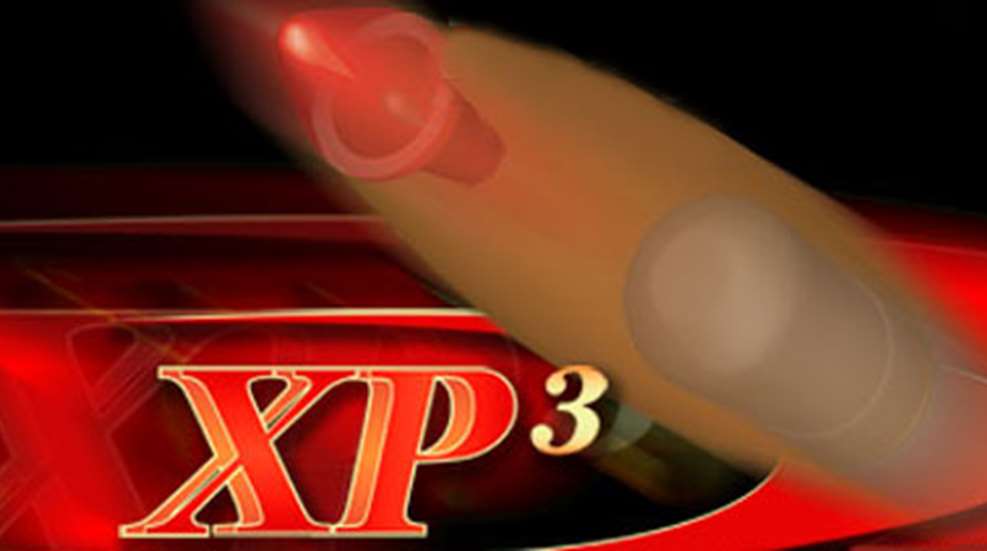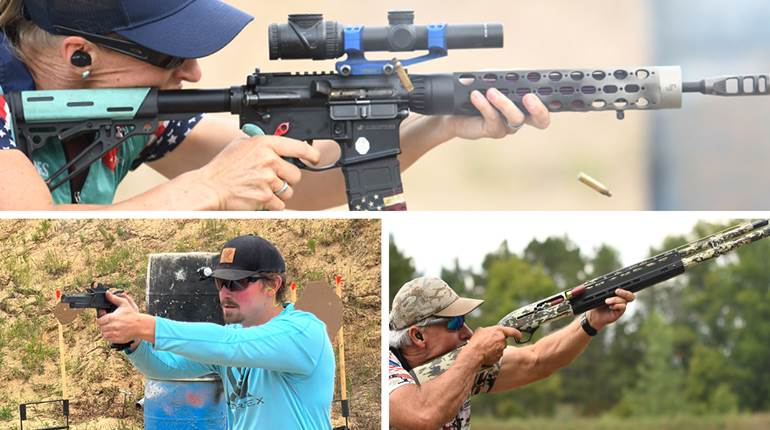
Pt's a ritual of sorts. Whether you get into hunting camp by plane, boat or truck, after finding out where to stow your gear, your guide or professional hunter gets you to unpack your rifle and whisks you off to the range in the fading hours of that first day to check the zero of your rifle. Be wary of any outfitter that doesn't, because, odds are, he isn't worth his salt. Verifying that your rifle still shoots where you want it to after being subjected to the tender mercies of the average airline baggage handler or a change in elevation or temperature is just plain common-sense. But it's also an interview.
Whether you know it or not, while making casual, friendly conversation, your guide is trying to find out about you and your equipment. It's his job. There are three things he needs to know before going afield: First, whether your rifle has the mechanical accuracy needed to take game at the ranges you'll likely encounter. Second, how well you can shoot it, as that will determine how long a shot he feels comfortable letting you take. (I once inadvertently overheard a guide refer to a nice hunter, but hopeless marksman, in camp with me as a "25 yarder.") And third – and the reason for this article – whether the bullet you've selected is up to the job.
Your answer to that last question is a key part of the interview. On an elk trip to Idaho, I noticed a slight, almost imperceptible, frown crease my guide's face as the .30-'06 Winchester Model 70 came out of the case. He didn't say a word about the chambering (many consider the .30-'06 "light" for elk) but immediately asked, "What bullet are you using?"
"These 180-gr. Winchester Fail Safe's shoot into just under an inch-and-half at 100 yards, and I set my zero for 150," I replied as I racked in the first round. The almost-frown disappeared as the first shot impacted right where I said it would on the stapled-up paper plate 125 yards away. "That's a good bullet," he said. I had passed the test.
"Good bullet" is as high a praise as a guide or professional hunter can bestow on a design. And it's not just whether it's a good bullet overall, but it has to be a good bullet for the specific type of game you're hunting.
When a guide says "good bullet," he usually means a premium one. One that's accurate and tough, the latter meaning better terminal performance than a bullet of standard construction. Not that other bullets are bad-they're not-it's just that hunting professionals see first-hand the advantages of premium, deep-penetrating bullets, day-in and day-out. The bullets that usually make guides extra happy are in the class of the Barnes-X, Nosler Partition, Swift A-Frame, Trophy Bonded Bearclaw and Winchester Fail Safe. They are designed to have controlled expansion and to hold together for the deep penetration you sometimes need when you take a less-than-optimum shot. You may never need that extra margin, but it's nice to have it.
So if Winchester's Fail Safe is part of the "good bullet" group, why on Earth would Winchester look to add another design-the XP3-to its line? The answer lies in recent technological advances in bullets.
The Fail Safe is more than a decade old. In its day, it was on the cutting edge of bullet design – and it's still very, very good. But it's also expensive to produce – with more than 30 different steps required in its manufacture – and it uses a steel insert for a mechanical lock to control expansion. The insert above the core was added to prevent the core from blowing forward through the jacket material under impact. Bonding, whether by heat or chemical processes-produces similar controlled expansion. The XP3 combines elements of the Fail Safe and two bullets that are a product of Winchester's Combined Technology relationship with Nosler Bullets-the Ballistic Silvertip and the AccuBond – even though the XP3 was designed in-house by Winchester's engineers.
On the accuracy side, it has a boattail and a translucent red polymer tip. These give the bullet a higher ballistic coefficient than a standard bullet with a flat heel, and thus greater potential accuracy and in-flight ballistic performance. The tip provides a 15-percent higher BC than one without it. In shooting groups of 180-gr. XP3 Supreme Elites vs. 180-gr. Supreme Fail Safes at 100 yards out of the same .300 WSM New Ultra Light Arms Model 20, I found the XP3 averaged 0.91 inches vs. 1.31 inches for the Fail Safes for five consecutive five-shot groups fired off of sandbags. Now granted, this was one rifle, on one day, with only a few boxes of ammunition and is no way a definitive test. But it does provide a glimpse of the bullet's potential performance. Also, the copper jacket is coated with Lubalox, a black-oxide finish intended to reduce barrel friction.
But getting the bullet there is only half the equation. There are two trade-offs in bullet design that must be balanced over a wide range of anticipated impact velocities: expansion and penetration. Generally, the more a bullet opens up, the more damage it does. But if expansion occurs too rapidly, the bullet can fail to penetrate deeply enough to reach vital organs. To get the best balance of the two, Winchester designed the XP3 to have what it calls Two-Stage Expansion. The first stage has to do with the opening of the tip into a four-petal X-shape, while the second is the compression of the core and jacket into a "bulge" where the core and jacket meet, meaning the bullet continues to push through, disrupting tissue, while the X-shaped petals cut through it at the same time. This bulge is a common sight on mechanically locked bullets, such as the Swift A-Frame and today's bonded bullets, too.
The XP3's hollow-point cavity is under the tip, and it has X-shaped petals specifically engineered to open up into four separate, partitioned petals that peel back under impact – just like the Fail Safe. "Notching is done early on in the manufacturing process to give the fault lines symmetrical upset for deep, straight penetration," according to Mike Stack, Winchester's centerfire rifle new product development engineer. Also like the Fail Safe, the jacket material is a copper alloy with some zinc added to it. The XP3's top half is copper alloy, while the jacket extends to the base with the lead core exposed on the heel. The lead core adds weight to the rear of the bullet, and it is bonded to the jacket. Under impact, that bonding prevents the lead from fully expanding, and the core and jacket are compressed together, forming the bulge at the center of the bullet.
The overall length of the .308, 180-gr. bullet is 1.371 inches, with 0.164 inches of that being the tip. The jacket material from the beginning of the hollow-point to the top of the lead core measures 0.617 inches. The lead core is thinner at its front to help prevent it from moving forward under impact. In the .308, 180-gr., the core measures 0.232 inches at its thickest but tapers 0.220 inches at its top.
A typical sample bullet fired into 20-percent ballistic gelatin at between 2,800 and 2,900 f.p.s. tells the story of what's happening inside the bullet. The recovered bullet's weight is 177 grs., its height shrank to 0.680 inches, and its outside diameter at its widest point is 0.618 inches. Inside, the front jacket material has been pushed to a height of 0.223 inches, while the core has expanded from 0.220 inches at the top to 0.356 inches at its widest, almost T-shaped, point. The exterior measurement at the "bulge" went from .308 inches to 0.428 inches. The core has also moved slightly forward from the base of the heel upon compression from the impact. In Winchester's tests, weight retention has ranged from 84 percent up to 99 percent, with higher velocity impacts in the 3,200 f.p.s. range being on the lower side and impacts in the 2,800 f.p.s.-range and lower giving the higher numbers.
Through high-speed photography, you can clearly see that the 180-gr., .308 XP3 opens to its full diameter (about 0.625 inches) within the first inch or so of impact, creating both a large temporary wound cavity that later contracts and a permanent wound cavity. What is impressive is its penetration of typically 19 to 23 inches in 20-percent ballistic gelatin at velocities ranging from the muzzle out to a simulated 400 yards. In direct comparison to 180-gr. Power Point WSM loads, the temporary wound cavity is larger with the Power Points, but penetration is about 50 percent greater with the XP3. These are "great long-range bullets and great close-up bullets," said Stack. "There aren't a whole lot of bullets that offer this range of performance. This bullet will open consistently from 3,200 f.p.s. down to 1,600 or 1,700 f.p.s.."
As to its terminal performance on game, I simply don't know firsthand yet, as the trip I sighted-in my New Ultra Light Arms for was cancelled and I ended up with nothing more than a nice target on my refrigerator. Nonetheless, my friend and colleague, American Hunter Editor-In-Chief Scott Olmsted, was in on one of the first hunts with the XP3.
"When we started looking to upgrade the Fail Safe and trying to right the wrongs that were there," said Stack, "we were trying to come up with a bullet that walloped deer, but would perform well all the way up to elk." From what I've seen and heard, Winchester's succeeded in meeting or beating that goal. And, I am confident that, in time, another bullet will join those on which guides and professional hunters confer their highest praise. The XP3 is a "good bullet."






































